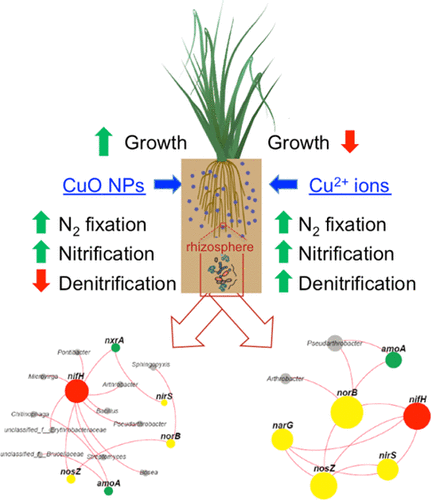当前位置:
X-MOL 学术
›
Environ. Sci. Technol.
›
论文详情
Our official English website, www.x-mol.net, welcomes your
feedback! (Note: you will need to create a separate account there.)
CuO Nanoparticles Alter the Rhizospheric Bacterial Community and Local Nitrogen Cycling for Wheat Grown in a Calcareous Soil.
Environmental Science & Technology ( IF 10.8 ) Pub Date : 2020-06-24 , DOI: 10.1021/acs.est.0c00036 Xiangyu Guan 1 , Xiaoyu Gao 2 , Astrid Avellan 2 , Eleanor Spielman-Sun 2 , Jiang Xu 2 , Stephanie Laughton 2 , Jie Yun 2 , Yilin Zhang 2 , Garret D Bland 2 , Ying Zhang 2 , Ruirui Zhang 1 , Xusheng Wang 1 , Elizabeth A Casman 3 , Gregory V Lowry 2
Environmental Science & Technology ( IF 10.8 ) Pub Date : 2020-06-24 , DOI: 10.1021/acs.est.0c00036 Xiangyu Guan 1 , Xiaoyu Gao 2 , Astrid Avellan 2 , Eleanor Spielman-Sun 2 , Jiang Xu 2 , Stephanie Laughton 2 , Jie Yun 2 , Yilin Zhang 2 , Garret D Bland 2 , Ying Zhang 2 , Ruirui Zhang 1 , Xusheng Wang 1 , Elizabeth A Casman 3 , Gregory V Lowry 2
Affiliation

|
The application of nanoparticles (NPs) to soils, as either fertilizers or fungicides (e.g., CuO NPs), has been proposed to improve the sustainability of agriculture. The observed effects could result directly from the NP–plant interactions or indirectly through effects on the soil microbiome. The objective of this study was to assess the effects of CuO NPs on the changes in the bacterial community structure and nitrogen-cycling-associated functions in a high pH soil and to correlate these changes with nitrate accumulation, soil parameter changes, and plant growth over 28 days. Triticum aestivum seedlings were exposed to 50 mg/kg CuO NPs, 50 mg/kg CuSO4, or 0.5 mg/kg CuSO4 in a standard soil (Lufa 2.1 soil, pH adjusted to 7.6). While Cu treatments reduced nitrate accumulation in the bulk soil, the effects were opposite in the rhizosphere (the soil influenced by root exudates). While nitrate accumulation in bulk soil negatively correlated with total Cu concentration, part of the nitrate concentration in the rhizosphere was explained by root uptake during plant growth, the rest being modulated by Cu treatments. The abundance of genes involved in the nitrogen cycle in the rhizosphere soil correlated with the ionic copper concentration. The increased nitrate concentration in the rhizosphere correlated with an increase of the gene abundance related to the nitrogen fixation and a decrease of denitrification gene abundance. Microbial diversity in bulk or rhizosphere soil under the different treatments alone could not explain these variations, while differences in the assemblages of bacteria associated with these functional gene abundances gave good insights. This study highlights the complexity of microbial N-related function in the rhizosphere and the need to characterize the rhizosphere soil, plant growth and root activity, NP (bio)transformations, along with microbial networks, to understand the impact of agrochemicals (here CuO NPs) on soil fertility.
中文翻译:

CuO纳米颗粒改变了石灰质土壤中小麦的根际细菌群落和局部氮循环。
已经提出将纳米颗粒(NPs)作为肥料或杀真菌剂(例如,CuO NPs)应用于土壤,以改善农业的可持续性。观察到的影响可能直接来自NP与植物的相互作用,也可能间接地通过对土壤微生物组的影响。这项研究的目的是评估高pH土壤中CuO NPs对细菌群落结构和氮循环相关功能变化的影响,并将这些变化与硝酸盐累积,土壤参数变化和植物生长相关联。 28天 将普通小麦幼苗暴露于50 mg / kg CuO NP,50 mg / kg CuSO 4或0.5 mg / kg CuSO 4在标准土壤中(Lufa 2.1土壤,pH调整至7.6)。尽管铜处理减少了散装土壤中硝酸盐的积累,但在根际(土壤受到根系分泌物的影响)的作用却相反。虽然散装土壤中的硝酸盐积累与总Cu含量呈负相关,但根际中硝酸盐浓度的一部分可以通过植物生长过程中的根吸收来解释,其余部分通过Cu处理来调节。根际土壤中参与氮循环的基因丰度与离子铜浓度相关。根际中硝酸盐浓度的增加与与固氮相关的基因丰度的增加和反硝化基因丰度的降低相关。单独进行不同处理后,散装土壤或根际土壤中的微生物多样性无法解释这些差异,而与这些功能基因丰度相关的细菌组成的差异提供了很好的见解。这项研究强调了根际微生物氮相关功能的复杂性,以及表征根际土壤,植物生长和根系活性,NP(生物)转化以及微生物网络的特征的必要性,以了解农药的影响(此处为CuO NP )在土壤肥力上。
更新日期:2020-07-21
中文翻译:

CuO纳米颗粒改变了石灰质土壤中小麦的根际细菌群落和局部氮循环。
已经提出将纳米颗粒(NPs)作为肥料或杀真菌剂(例如,CuO NPs)应用于土壤,以改善农业的可持续性。观察到的影响可能直接来自NP与植物的相互作用,也可能间接地通过对土壤微生物组的影响。这项研究的目的是评估高pH土壤中CuO NPs对细菌群落结构和氮循环相关功能变化的影响,并将这些变化与硝酸盐累积,土壤参数变化和植物生长相关联。 28天 将普通小麦幼苗暴露于50 mg / kg CuO NP,50 mg / kg CuSO 4或0.5 mg / kg CuSO 4在标准土壤中(Lufa 2.1土壤,pH调整至7.6)。尽管铜处理减少了散装土壤中硝酸盐的积累,但在根际(土壤受到根系分泌物的影响)的作用却相反。虽然散装土壤中的硝酸盐积累与总Cu含量呈负相关,但根际中硝酸盐浓度的一部分可以通过植物生长过程中的根吸收来解释,其余部分通过Cu处理来调节。根际土壤中参与氮循环的基因丰度与离子铜浓度相关。根际中硝酸盐浓度的增加与与固氮相关的基因丰度的增加和反硝化基因丰度的降低相关。单独进行不同处理后,散装土壤或根际土壤中的微生物多样性无法解释这些差异,而与这些功能基因丰度相关的细菌组成的差异提供了很好的见解。这项研究强调了根际微生物氮相关功能的复杂性,以及表征根际土壤,植物生长和根系活性,NP(生物)转化以及微生物网络的特征的必要性,以了解农药的影响(此处为CuO NP )在土壤肥力上。











































 京公网安备 11010802027423号
京公网安备 11010802027423号